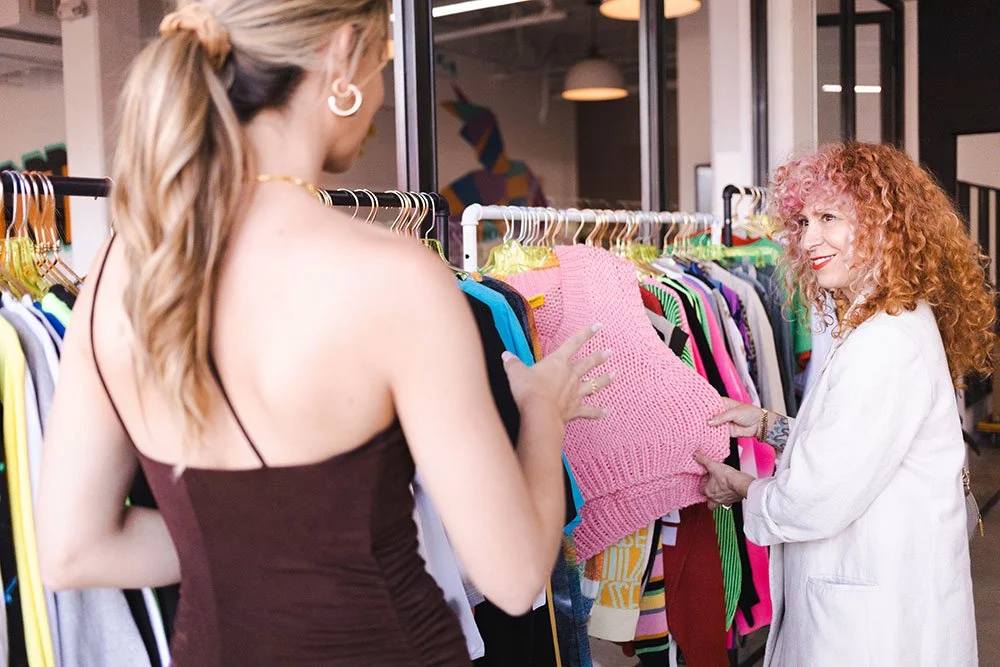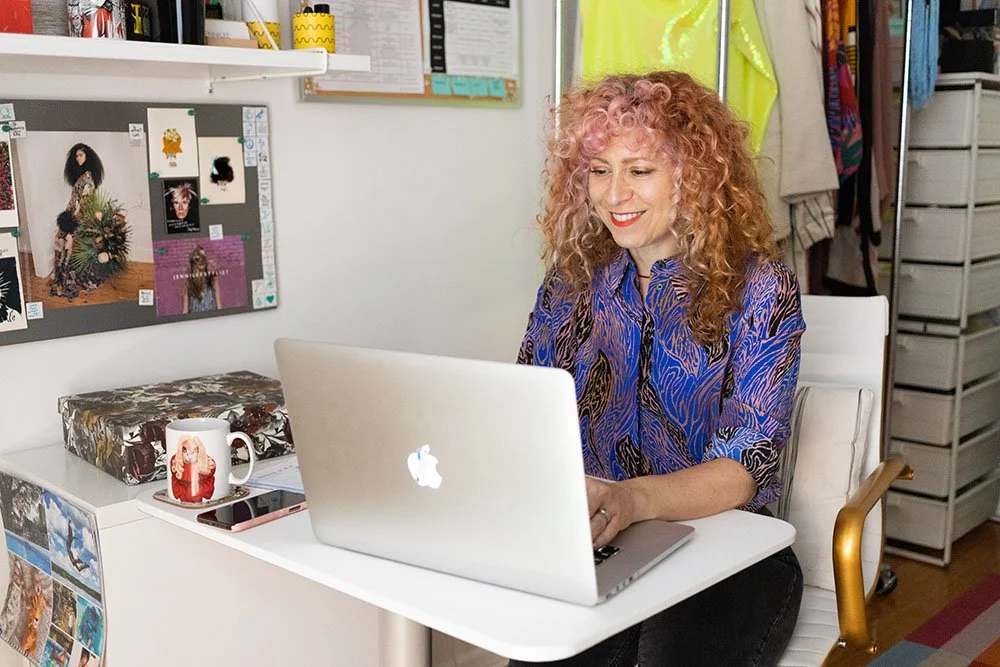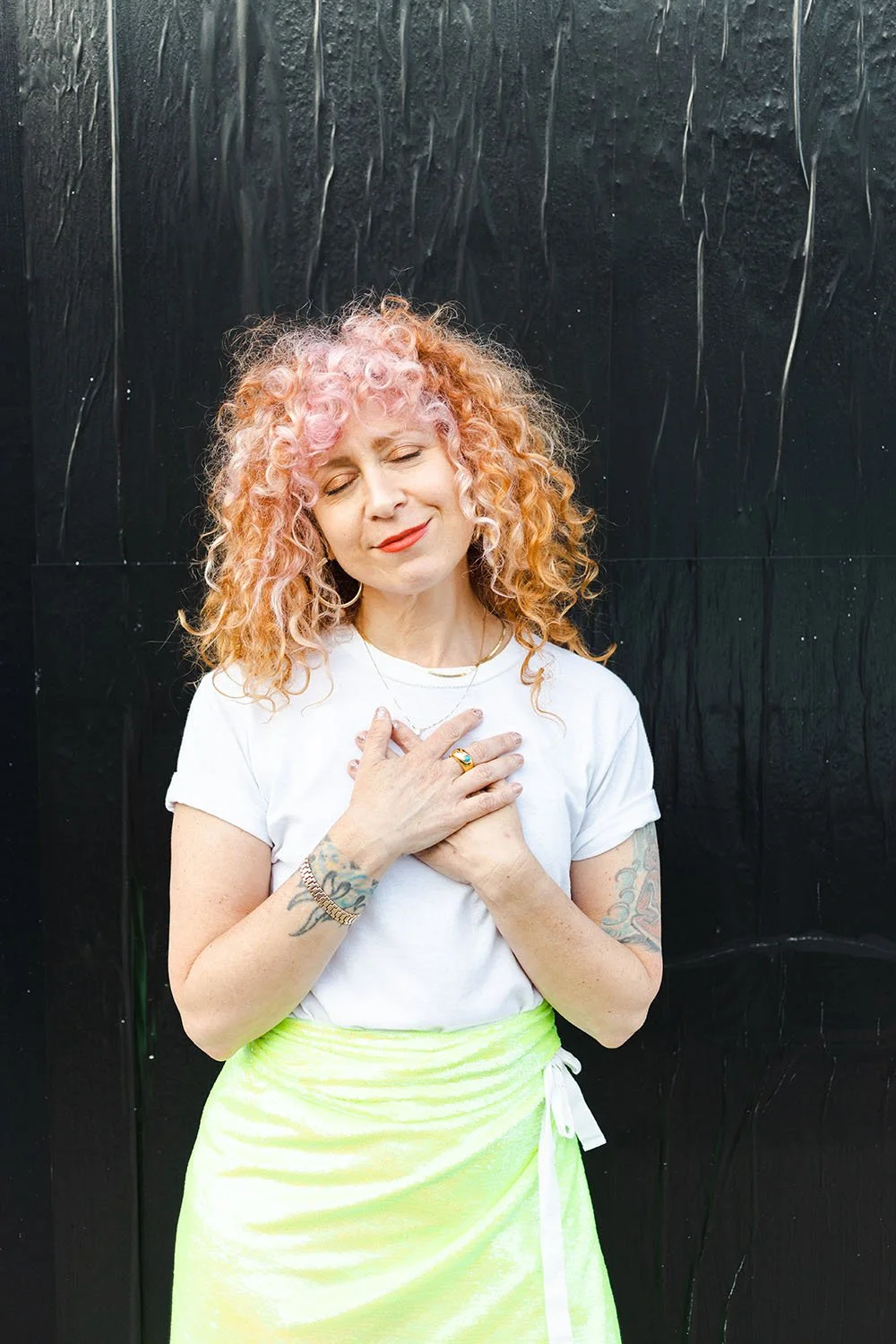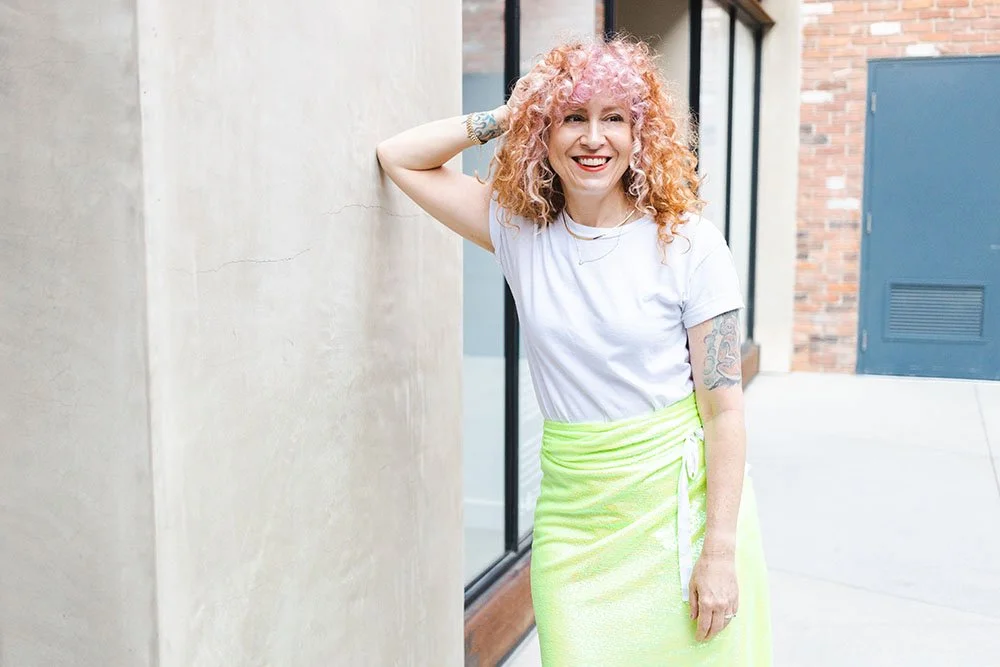Dressing For Who You’re Becoming: A Stylist’s Take on Identity, Confidence, and the Deeper Meaning of Personal Style
This article is part of TruForm, an ongoing series with creative minds exploring the emotional layers of how we dress, dwell, and define ourselves in ways that bring us closer to true form.
In this conversation, we explore stylist JenniLee’s take on how personal style becomes a vehicle for identity, confidence, and transformation , interpreted through a fashion psychology lens.
When stylist and image consultant, JenniLee pivoted from celebrity shoots to personal styling, it wasn’t just a career change, it was a deeper call to help women step into themselves. Bold, practical, and a bit playful, JenniLee helps ambitious women get dressed for who they’re becoming. Her work isn’t just about fashion, it’s about well-being, using clothes to move through transitions, regulate anxiety, and reconnect with creativity. As a fashion psychologist, I was struck by how seamlessly her work aligns with psychological principles that most people never think about when standing in front of their closets.
This interview blends JenniLee’s refreshing insights with reflections on the psychology behind her methods, making it part conversation, part deep dive into personal style psychology. Read on for grounded advice on cultivating personal style, working through closet overwhelm, and dressing with intention.
You’ve styled red carpets, music videos, and now serve high-achieving women through your Bespoke Style Program. What prompted the shift from celebrity to personal styling?
JenniLee: A few years before the pandemic, I had one personal client who wasn't a celebrity. She was a spiritual life coach with an online business and needed to promote herself digitally. I kept saying, "You're my unicorn—I work in fashion with a capital F!" But I loved helping her. The transformation she went through was powerful. When the pandemic hit and the industry paused, I leaned in. We had already started Zoom sessions and I thought, "If not now, when?"
Psych Insight: JenniLee’s work highlights how clothing can support changes in other areas like identity, confidence, and emotion. Her experience with clients show how, clothing can be a bridge between current identity and the version of themselves they’re stepping into.
What made you want to work specifically with successful, creative women? Was there a throughline or pattern you noticed that drew you in?
JenniLee: As a fashion stylist for over 20 years, I’ve always worked with creative people— incredible photographers, musicians, creative directors, and actors. So when I moved into personal styling, I naturally attracted people who wanted to be more creative. Style is creative expression. I help women tap into that, no matter their profession. Through my Style Quiz—which helps women identify their unique style personas from 20 different results—I’ve seen how creativity shows up in so many different ways, even in people who don’t consider themselves artistic.
Psych Insight: This speaks to fashion as a form of dramaturgy—a way to act out different roles, explore selves, and engage in a daily practice of meaning-making. JenniLee’s Style Quiz reinforces this by helping clients identify and play with evolving style identities, giving them language and confidence to experiment without falling back on overused trends or expectations.
You’ve talked about using fashion to process trauma. How do you approach styling when a client is navigating something difficult or sensitive?
JenniLee: We all carry trauma, like heartbreak or the grief of losing a loved one. I lost all my belongings in a fire as a child, so I know what it’s like to lose everything that felt familiar. I see clothes as something that can comfort and protect us—almost like armor. When someone is going through something hard, the first thing I do is listen. We talk about how they want to feel in their bodies and how they want to see themselves. That’s how we begin to build their personal style. With my Bespoke clients, I stay close, offering daily text support because sometimes getting dressed can feel incredibly vulnerable, and it helps to have that real-time encouragement.
Psych Insight: This reflects a trauma-informed approach to style. Clothing, in this context, becomes a form of emotional scaffolding—something that can soothe, protect, and help regulate the nervous system. JenniLee’s method shows how attuned styling support can help clients feel safe enough to reconnect with their bodies and experiment with identity in a manageable, grounded way.
One of the things I love about your approach is how you help ease anxiety through fashion. What does that look like in a client’s wardrobe?
JenniLee: You don’t want your closet to add stress. To be human in this day and age means living with a certain level of anxiety already—so getting dressed shouldn’t add to it. One of the first things I do is a closet cleanse. We talk through each piece—why they have it, if it serves them. I’m not into capsule wardrobes or telling people to get rid of everything—that can be wasteful, and kind of cruel.
I believe there’s a place in everyone’s wardrobe I like to call the "photo album." It’s where we keep meaningful items we won’t wear again, clothes that hold special memories or were worn during amazing experiences. They’re like photographs in fabric form—you don’t need to wear them, just visit them. When we acknowledge them as memory holders, we can move them out of daily rotation and release the guilt that often comes with holding onto things. You don’t need to justify keeping something if it carries meaning or is meant for someone you love later. That’s not hoarding, that’s human. And honestly, that’s kind of beautiful.
Psych Insight: JenniLee’s approach invites clients to rethink their relationship with clothing by assigning emotional roles to certain pieces, like memory holders or symbols of transformation. This taps into object attachment theory, which explains how we form deep bonds with meaningful items.
It also aligns with narrative theory, the idea that people shape their identity by telling and reframing the stories of their past. In this context, holding space for memory pieces turns emotional clutter into a story of self—one that fosters clarity, acceptance, and emotional wellbeing. By externalizing memories and organizing by emotional function, clients reduce anxiety and release guilt, reclaiming their wardrobe as a space for clarity and self-compassion.
What’s one piece of advice you’d give to women navigating fast fashion fatigue, who want a thoughtful, high-quality wardrobe without blowing their budget?
JenniLee: Go cold turkey on fast fashion. Start by unsubscribing from the worst offenders—Shein, Zara, Brandy Melville, Temu, Amazon brands, ASOS. Then ask yourself, “Do I already have something like this in my closet?” If yes, wear that. If no, then whatever trend you’re compelled to chase, search for it on resale. There’s an incredible app, Gem, that aggregates global resale. You can search “purple pants, Roberto Cavalli, size 10” and find options. That dopamine rush doesn’t go away, it just shifts to something more intentional.
If it all feels like too much, I suggest joining My Style Club, my monthly group styling community. Members get curated finds from me in their size and budget. Recently, a member said she wanted midi skirts. So I pulled 13 amazing designer options in her size and price range from The RealReal, and posted the links in the member platform. Having that community support and shared wisdom makes such a difference.
Psych Insight: JenniLee’s approach reframes the thrill of fast fashion into something more sustainable and self-affirming. By naming specific brands and redirecting that same urge toward secondhand “treasure hunting,” she’s shifting a compulsive behavior loop into a conscious one. This aligns with cognitive behavioral principles. By changing the behavior—what you click, search, or buy—you interrupt automatic thought patterns and create space for more intentional choices.
You still feel the thrill, but now it reinforces an appreciation for well-made pieces and begins to change how you show up. She’s shifting the habit loop, turning compulsive fast fashion shopping into intentional discovery, which also boosts confidence.
With so much coming at us—trends, influencer style, flash sales—it’s easy to lose sight of what actually feels true to us. What’s one piece of advice you would give to help women stay grounded in their own personal while still leaving room to evolve and experiment?
JenniLee: Yes, we’re bombarded—with trends, all the “cores”, and style influencers—and while a signature style is a great way to find pieces that feel authentically you, it can also feel like a trap or box that keeps you from experimenting. My Style Quiz, which helps women discover their primary style persona out of 20 different results, gives a foundation to build from while still allowing room to evolve and experiment as their mood or situation changes.
Style is the easiest way to express yourself creatively, and like any muscle, creativity needs to be exercised. Trying things on outside your comfort zone keeps it active. One of my favorite practices is taking clients to luxury stores just to try things on. I advise my clients to wear all black (with a fitted t-shirt and pants that’s easy to take on and off and pairs with everything), with nice mid-size heels that make you feel professional, and try on designer clothes that aren’t part of your usual style.
Sometimes I’ll even go shopping with clients to help them navigate this process. There’s no pressure to buy—just feel the fabric, notice the tailoring, see how your body responds. If you love something, take a photo of yourself and the tags. If you’re still thinking about it weeks later, start searching for it online. But if that’s too overwhelming, call in the professional (hi, hello!).
When you invest more, whether time or money, in your wardrobe, your more likely to take care of your clothes. And when you take care of your belongings, you’re taking care of yourself, and that feels good.
Psych Insight: JenniLee’s shopping trips mirror exposure therapy—offering clients safe, embodied experiences that challenge their internal narratives. By stepping into elevated pieces, even temporarily, they disrupt limiting beliefs around worth, style, and identity. That shift can boost confidence because it’s based on direct experience, not external approval. It also activates enclothed cognition—the idea that wearing clothes with symbolic meaning can shift how we think, feel, and act.
You talk about style as a reflection of self-worth and recognition. Can you share a client story that shows how styling helped them level up in life or work?
JenniLee: I had a client just shy of 50 whose closet was full of clothes she didn’t feel good about. She kept cycling through the same five pieces—things that felt both too frumpy and too youthful—and nothing made her feel confident. Getting dressed became so stressful she started saying no to dinners, events, even networking. She was beginning to isolate.
I did a full in-person closet audit with her. We styled outfits from what still worked, let go of what didn’t reflect who she was becoming, and shopped together for strategic additions. We kept it minimal, but the new pieces paired so well with what she already had that she ended up with dozens of fresh outfit combinations. Through ongoing Zoom sessions and quick daily texts, she had support whenever she needed it.
Months later, she told me she was going out again—networking, dating, showing up. People remembered her. She felt more confident, wore what fit, and had things tailored. After turning 50, she said she felt younger than she had in years because she was finally dressing in a way that matched how she felt, instead of letting numbers like age or size define what she could wear.
Psych Insight: This story reflects how clothing can bridge the gap between how we feel and how we want to feel—what psychologists call self-discrepancy theory. When we dress in a way that aligns with our ideal self, we feel more at ease in our identity. But it’s not just internal. As JenniLee’s client began showing up differently, others responded, validating her shift. That feedback loop is key to symbolic interactionism, which reminds us that confidence doesn’t just come from within—it’s shaped by how we’re seen and how that reflection, in turn, reshapes us.
Some clients know they want to elevate their style but fear stepping into the next version of themselves. How do you support women who are hesitant to dress for the person they’re becoming?
JenniLee: Baby steps! I never suggest a full overhaul. It’s about pulling the best from what’s already in your closet and then being strategic about what you bring in. Many clients aren’t totally sure how they want to elevate, so we start with what I call “style flashcards”—scrolling through street style images quickly to see what turns them on, what sparks curiosity, and how to bring that into real life.
We explore this in depth during group styling sessions too. The women in Style Club are great at helping each other name what feels true versus what feels like trying too hard. That support is huge. Because if something makes you feel itchy or tight or you’re tugging at it, that discomfort shows. When you feel good in what you’re wearing, you move differently—and people feel that confidence. With my Bespoke clients, we even use Voxer so they can text me outfit pics and get support in real time.
Psych Insight: JenniLee’s method reflects scaffolding—offering clients just enough support to explore new styles without feeling overwhelmed. Tools like style flashcards, group feedback, and daily check-ins help ease them into change. This mirrors cognitive behavioral therapy’s use of gradual exposure—the idea that trying small, low-pressure versions of something new can quiet anxiety and build confidence over time.
How would you describe your personal style today, and has it been impacted by your work with clients?
JenniLee: I’d describe my personal style as joyful and welcoming. I’m an extroverted introvert, so I use clothing as an icebreaker—something that invites conversation. My clothes give people a way to connect with me.
These days, comfort matters more than it did in my 20s—I’m not in sky-high platforms for 12 hours anymore. But every piece in my closet still feels like me. When I get dressed, I ask myself: Where am I going? Who am I getting in front of? What story am I telling today? How can this outfit help me connect with the people I’m working with?
If someone’s ready to explore their own style story, my Style Quiz is a great place to start. It helps you identify one of 20 style personas and gets you on my newsletter, where I share more tools and insights like this.
Psych Insight: JenniLee’s approach to dressing embodies enclothed cognition—the idea that what we wear, when it holds symbolic meaning, can shift how we think, feel, and behave. Her clothes act as a kind of social shorthand, helping her initiate connection and feel aligned with the moment. This also reflects symbolic interactionism, where style becomes a tool for meaning-making and impression management—a way to communicate identity and intention through social interaction.
Quick Takes with JenniLee
Before we wrap, we asked JenniLee a few rapid-fire questions to peek further inside her personal style, and the pieces that hold meaning, memory, and mood.
Favorite grounding fabric right now?
It’s summer, so 100% cotton T-shirts.
Vintage piece you’ll never part with?
Too many to name, but primarily pieces from my Nana Kitty's closet, my mom's vintage band tees, my nameplate necklace from Nana when I was 16, and my 1920s wedding dress.
What piece in your closet gets worn way more than it should?
My Rachel Comey barrel leg jeans and white Nike Rift tabi sneakers.
One song that captures your styling moodboard?
"She’s a Rainbow" by The Rolling Stones.
Style Psychology Takeaways from JenniLee
Throughout our conversation, certain psychological themes kept surfacing, offering a deeper look at how style can support identity, confidence, and everyday well-being. Here are some of the key insights drawn from JenniLee’s approach:
Clothing can comfort, protect, and emotionally regulate—especially during periods of stress or transition.
Organizing your closet by emotional function (like JenniLee’s “photo album” section) can reduce anxiety and increase clarity.
Shopping secondhand rewires the dopamine hit of fast fashion into intentional discovery and self-knowledge.
Exposure to quality clothing—without pressure to buy—can challenge limiting beliefs and shift self-perception.
Style flashcards and mood boards reduce overwhelm and help clarify aspirational identity.
Dressing for how you feel (rather than a number or trend) builds confidence that resonates outward.
Thanks JenniLee!
For more on her styling philosophy—or to discover your own style persona—follow her on Instagram @jennileestylist and take the Style Quiz at JenniLee Stylist: Personal Styling & Image Consulting.
Inspired by something in this conversation? Let us know in the comments—what’s one piece in your closet that tells your story?
This is an ongoing series exploring fashion and design psychology. Support contributors and keep TruForm interviews going by joining us on Patreon.
All photos in this piece are courtesy of JenniLee.
Written by Sarah Seung-McFarland
Sarah Seung-McFarland, Ph.D., is a licensed psychologist with a specialty in fashion and design psychology, and founder of Trulery.








